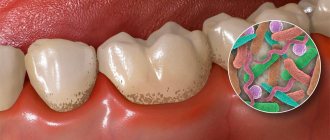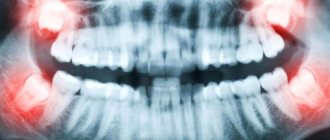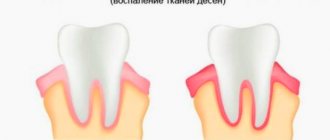Every person experiences a sore throat sooner or later. But this seemingly harmless symptom can cause serious problems.
Acute tonsillitis (tonsillitis) is an infectious disease that causes inflammation of the tonsils. Statistics show that about 15% of children suffer from an acute form of the disease. In the adult population, this figure is lower - 5-10%. But almost every person in large cities suffers from chronic tonsillitis. Why? Let's find out!
The acute form of tonsillitis, which goes away with an increase in body temperature and severe pain in the throat, is more familiar to us as a sore throat. In the chronic form, the patient may not even realize that he has this disease for a long time. A person may feel that periodic sore throats and frequent colds are simply the result of a weakened immune system. Such a careless attitude towards one’s health can cause serious complications and pathologies. To avoid them, it is necessary to diagnose the problem in time: know the first signs, symptoms and treatment.
Why are tonsils needed?
The tonsils are an integral part of our immune system. And their main purpose is to protect the body from the penetration of pathogenic bacteria and viruses. In total, a person has six of them: palatine and tubal (paired), pharyngeal and lingual. By their names you can roughly understand in which part of the pharynx they are located. Their general arrangement resembles a ring. This ring acts as a kind of barrier for bacteria. When we talk about inflammation of the tonsils, we mean only the palatine tonsils (aka tonsils). Let's look at them in more detail.
Types of tonsillitis.
The disease occurs in two forms - acute and chronic. Acute tonsillitis is an illness of an infectious nature and manifests itself in acute inflammation of the tonsil. The cause of exacerbation is staphylococci and streptococci. Acute sore throat in children and adults is also divided into catarrhal, follicular, lacunar, ulcerative-membranous and necrotic.
Chronic tonsillitis is a long-term, persistent inflammatory process in the tonsils. It manifests itself as a consequence of past inflammation, acute respiratory viral infections, dental diseases, and reduced immunity. Chronic exacerbation of the disease in adults and children occurs in three forms: compensated, subcompensated and decompensated. In the compensated form, the disease “dormants”; exacerbation of tonsillitis symptoms occurs infrequently. In the case of a subcompensated form of the disease, exacerbations occur frequently, the disease is severe, and complications are common. The decompensated form is characterized by a long, sluggish course.
Symptoms of tonsillitis.
A symptom that combines both types is pain in the throat. The pain can be both severe and tolerable. The patient experiences severe discomfort while eating and swallowing.
Sore throat is much more severe than a chronic disease and is accompanied by the following symptoms:
- increased body temperature (up to 40°C);
- very severe sore throat;
- enlarged lymph nodes;
- accumulations of pus on the tonsils (plaque, pustules);
- enlarged tonsils;
- headache;
- weakness.
The symptoms and treatment of chronic tonsillitis are somewhat different from the manifestations of tonsillitis. With a chronic disease, the temperature remains at 37°C. A sore throat, cough, and bad breath are added. There is a white coating on the tonsils. The symptoms are less pronounced, since the course of the disease itself is characterized by remissions and exacerbations. A patient suffering from a chronic form of the disease loses his ability to work, gets tired quickly, and loses his appetite. Often a person suffers from insomnia.
Causes of enlarged submandibular lymph nodes
Two groups of 6-10 lymph nodes, located symmetrically on the right and left in the tissue behind the arch of the lower jaw, collect lymph from the salivary glands, tonsils, palate, tongue, cheeks, nose, jaws and lips. Therefore, their increase is observed when these organs and tissues are damaged. Lymphoid hyperplasia is provoked by infections of the nasopharynx and oropharynx, dental pathology, local tumor processes, and may indicate the development of lymphoma and lymphogranulomatosis. Less commonly, damage to the lymph nodes is complicated by eye diseases - dacryoadenitis, stye on the eyelid.
ARVI
Infection with pneumotropic viruses is a common and obvious cause of benign lymphadenopathy, in which the submandibular and cervical lymph nodes simultaneously enlarge. Changes in the lymphoid tissue through which lymph from the oropharynx and nasopharynx are filtered are more noticeable with the development of ARVI during pregnancy and in children. In the first case, this is due to a physiological decrease in immunity to reduce the threat of miscarriage, in the second - with the age-related development of protective mechanisms.
Submandibular lymphadenopathy is more often observed with adenovirus infection, parainfluenza, infection with rhinoviruses or an association of viral pathogens. Typically, the lymphatic reaction is preceded by so-called catarrhal phenomena - runny nose, sore throat, pain when swallowing, dry cough, lacrimation. The temperature often rises, and to high (febrile) numbers - from 38 ° C and above. Characterized by moderate asthenia - weakness, weakness, fatigue. Muscle and joint pain is possible.
With ARVI, the skin over the submandibular lymph nodes has a natural color. The increase in lymphoid formations is slight (slightly more than 1 cm). The lymph nodes are compacted, but not rocky, have a smooth surface, and are mobile. During palpation, pain may be detected. As a rule, there is a symmetrical increase in nodes in both submandibular groups, which is associated with the spread of viral particles through the lymphatic system. As the infectious process subsides, the normal size and density of the submandibular lymph nodes are restored.
Sore throat and chronic tonsillitis
The second most common cause of enlarged submandibular lymph nodes is an infectious-inflammatory lesion of the palatine tonsils. Lymphadenopathy develops in both acute and chronic processes. With angina, the lymph nodes enlarge within 1-2 days from the onset of inflammation, in some cases reaching a diameter of up to 2 cm. The symptom occurs against the background of severe intoxication, an increase in temperature to 38-40 ° C, intense pain in the throat with painful swallowing and irradiation to the ears, severe headaches, muscle and joint pain.
With unilateral acute tonsillitis, the jaw lymph nodes on the corresponding side react more often; with bilateral acute tonsillitis, a lymphoid reaction is detected on the left and right. Often the cervical lymphatic groups are involved in the process. To the touch, the nodes are dense, painful, and mobile. The increase in size can persist for 1-2 weeks after the underlying disease subsides, then the diameter of the submandibular lymph nodes gradually decreases to normal, if the process has not become chronic.
Chronic tonsillitis is characterized by a symmetrical moderate enlargement of the nodes of both mandibular groups without involvement of the lymphatic formations of the neck. The pain is less pronounced. In a simple form of chronic inflammation of the tonsils, prolonged grade I lymphadenopathy often becomes the most noticeable manifestation of the disease. In patients with the toxic-allergic variant of tonsillitis, symptoms of damage to the tonsils are expressed with pain and sore throat, discomfort when swallowing, and bad breath. A persistent low-grade fever often persists.
Other infectious diseases
Damage to the submandibular lymph nodes is determined by a number of systemic infections, bacterial, viral and fungal processes affecting the respiratory system and salivary glands. The reaction of the submandibular nodes is due to the performance of a barrier function when pathogens enter the lymphatic system from the mucous membranes of the nose, oral cavity, and head organs. Mandibular lymphadenopathy manifests itself in such general and local infectious diseases as:
- Infectious mononucleosis
. The submandibular nodes are the first to respond to the introduction of the Epstein-Barr virus. Their increase is caused by lymphoid hyperplasia, primarily by the reaction of B-lymphocytes specifically affected by viral particles. At the initial stages of the pathological process, in addition to a local lymphoid reaction, low-grade fever is noted, a sore throat, and nasal congestion are felt. Later, the disease manifests itself as sore throat, generalized enlargement of the lymph nodes, liver and spleen. - Herpetic infection
. Hyperplasia of the lymph nodes of the submandibular groups is detected in herpetic stomatitis. Characterized by increased temperature, increased secretion of saliva, erosive and aphthous lesions of the oral mucosa. In addition to hyperplasia, inflammation of the lymphoid tissue with the development of mandibular lymphadenitis is possible. Kaposi's eczema herpetiformis is even more severe, in which the occipital and cervical lymph nodes are also affected, and vesicular, pustular, and erosive skin lesions are present. - Cytomegaly (CMVI)
. The involvement of the submandibular lymph nodes is due to the sensitivity of cytomegaloviruses to the ductal epithelium of the salivary glands with the occurrence of parotid sialadenitis as one of the pathognomonic signs of the disease. Submandibular lymphadenopathy is combined with the neck, high temperature, weakness, headache, and other signs of intoxication are determined. A clear clinical picture is observed in 4-5% of patients, while the manifestation of cytomegalovirus infection is more often observed in pregnant women. - Respiratory mycoplasmosis
. Moderate enlargement of the submandibular lymph nodes is characteristic of mycoplasma infections of the upper respiratory tract. Possible simultaneous damage to the cervical lymph nodes. Lymphadenopathy is preceded by a short period of catarrhal symptoms - a painful dry cough, runny nose with copious mucus, sore throat, injection of scleral vessels. In the future, respiratory mycoplasmosis can spread downward to the trachea, bronchi, and lungs. - Cat scratch disease
. The submandibular nodes are affected when a cat bite or scratch is localized in the facial area. Lymphadenopathy is quickly complicated by submandibular lymphadenitis. The combination of a lymphoid reaction with a reddish nodule (papule), and then an abscess (pustule) at the site of skin damage is pathognomonic. The inflamed lymph nodes are enlarged to 1.5-2 cm and are sharply painful. Lymphadenitis persists for up to 2 months and is accompanied by febrile temperature, weakness, fatigue, myalgia, and headache. - Scrofuloderma
. In lymphogenous colliquative tuberculosis of the skin, the leading symptom is the formation of dense reddish-purple nodes (tuberculous granulomas) in the area of the submandibular and cervical lymph nodes, from which dissemination of Koch bacilli occurs. An increase in lymphatic formations corresponds to lymphadenopathy I, less often II degree and complements suppurating subcutaneous tubercles, which break through fistulas and are slowly replaced by coarse scar tissue.
Dental pathology
The submandibular nodes serve as the main collectors of lymph from organs located in the oral cavity. Therefore, they are among the first to respond to any inflammation of the oral mucosa, dental tissue, upper and lower jaws. The reason for the enlargement of the lymph nodes is protective hyperplasia of the lymphoid tissue in response to the presence and proliferation of the pathogen, and in more severe cases, with lymphogenous spread of the process, infiltration of the stroma with inflammatory elements.
A moderately pronounced increase in the nodes of the submandibular group on the side of the pathology is observed in periodontitis, alveolitis, and periostitis of the jaw. Typically, lymph nodes become hyperplastic due to pain in the projection of the lesion, putrid odor from the mouth, low-grade or febrile fever, weakness, weakness, and other manifestations of intoxication. Submandibular lymphadenitis, which developed against the background of bright redness, multiple ulcerations, dirty gray plaque and foci of necrosis of the oral mucosa, is a sign of ulcerative necrotic stomatitis.
Malignant neoplasms
Lymphogenic metastases in the submandibular nodes are found in patients with late stages of oncological diseases of the head organs. A combination of mandibular lymphadenopathy with an increase in nodes of other groups is typical: for lip cancer - with mental and jugular nodes, for tongue cancer - with mental and occipital nodes, for cancer of the lower jaw - with cervical nodes, and for eye melanoma - with cervical and parotid nodes. Compaction and enlargement of the submandibular nodes is an important sign of malignant tumors of the salivary glands.
The detection of altered lymphatic formations usually indicates that the oncological process is old (early metastasis is typical only for tumors of the lower jaw and melanomas). The diameter of the nodes can reach 2 cm. To the touch they are defined as hard, rocky, sometimes have a bumpy surface, and are fused together with each other and the surrounding skin into a single conglomerate. Lymphadenopathy is preceded by pathognomonic signs of the tumor process - growths and ulcerations of the skin, mucous membranes, dense infiltrates, local pain, limitation of movements, etc.
Possible complications.
Both forms of the disease: chronic and acute, can cause serious complications. One of the most severe consequences of the disease is rheumatism. Practice shows that half of the patients suffering from rheumatism had to be treated for chronic tonsillitis or treated for acute conditions a month earlier. The disease itself begins with unbearable joint pain and increased body temperature.
There are frequent cases of heart disease caused by tonsillitis. Patients experience shortness of breath, interruptions in the functioning of the heart muscle, and tachycardia. Myocarditis may develop.
If inflammation spreads to tissues nearby the tonsil, paratonsillitis appears. The patient suffers from a sore throat and fever. If the infection from the tonsils spreads to the lymph nodes, lymphadenitis appears.
Untreated tonsillitis also leads to kidney disease.
Causes of pain
Drinking cold water with a “weak throat” can cause a sore throat
If the tonsil hurts on only one side, the causes must be sought in diseases of the throat of a viral or bacterial nature. Pain itself is not a disease. This is a symptom that can accompany various pathologies.
In general, an enlarged tonsil on one side is a sign of unilateral inflammation. The tonsils are an organ of the lymphatic system, and therefore react acutely to various pathological processes in the body caused by bacteria. Pain in the throat cannot be ignored, otherwise the disease may become chronic or cause complications. Among the probable reasons why the left or right tonsil hurts:
- tonsillitis (tonsillitis),
- pharyngitis,
- bacterial infection of the tonsils,
- fungal infection,
- Eagle-Sterling syndrome,
- mechanical damage to the lymphoid tissue of the tonsils,
- stomatitis,
- sinusitis,
- otitis.
Each of these conditions has specific signs that may suggest a diagnosis.
Causes and symptoms of tonsillitis
If the tonsil hurts on only one side, you first need to rule out the most likely cause - tonsillitis. In everyday life, the disease is known as sore throat, and is one of the most common throat problems in children and adults.
If the tonsil is swollen on only one side, we are talking about acute unilateral tonsillitis.
Typical symptoms:
- sore throat on one side, worsening when swallowing,
- increase in body temperature to 38 degrees or higher,
- general malaise,
- plaque on the affected tonsil,
- Upon examination, redness and swelling of the tonsils are noticeable.
In most cases, the disease is caused by a bacterial infection, less often by viruses or yeast. The disease develops against a background of weakened immunity, in particular due to hypothermia.
Important! Tonsillitis must be treated promptly, otherwise it becomes chronic. In this case, the disease recurs at the slightest weakening of the immune system.
Another cause of an enlarged right tonsil is chronic sinusitis (sinus disease). In this case, the infection simply spreads to the tonsils, causing pain and inflammation.
Pain in tonsils with pharyngitis
Frosty air in winter can lead to irritation of the larynx and, as a result, its inflammation
Another common disease is pharyngitis. It is an inflammatory process that affects the mucous membrane of the pharynx and the lymphoid tissue of the tonsils. If the tonsil is inflamed on only one side, pharyngitis must be ruled out.
Causes of the disease:
- inhaling too cold or too hot air,
- irritation of the mucous membranes by chemicals,
- complicated infections of the mouth or sinuses,
- advanced caries,
- bacterial infection, fungal infection of the mucous membrane,
- pharynx injuries.
The disease begins with a sore throat and dry mucous membranes. Pain when swallowing occurs several days after the onset of the inflammatory process. Moreover, the pain can also be one-sided, as with tonsillitis, if we are talking about inflammation of the tonsil on one side. However, pain in the tonsils with pharyngitis is a secondary symptom; the primary symptom is redness and swelling of the mucous membrane of the entire pharynx.
Pregnancy and chronic tonsillitis.
The health of the expectant mother and baby requires close attention. Complications caused by the disease can lead to dangerous consequences, including miscarriage or provoke premature birth. Self-medication in this case is dangerous: it is necessary to undergo treatment with an ENT specialist in the clinic. The doctor will prescribe washing the tonsils, treating them with ultrasound and gargling with antiseptics that are safe for the expectant mother. Physiotherapy is contraindicated for pregnant women.
If you are just planning a pregnancy, it is worth carrying out planned therapy for prevention in order to reduce the negative impact of pathogens on the tonsils. At the planning stage of pregnancy, it is recommended that both parents undergo an examination to reduce the risk of this disease in the child.
Preventive measures
To keep your tonsils healthy, you need to:
- avoid hypothermia, stress and anything that potentially threatens a decrease in immunity,
- promptly treat any infectious diseases,
- visit the dentist regularly, avoid caries and treat your teeth in a timely manner,
- avoid injury to the tonsils.
If a person is prone to throat diseases, you can consult a doctor about taking prophylactic medications to boost immunity. Quitting smoking will help reduce the risk of developing tonsillitis and pharyngitis.
Acute tonsillitis. Treatment.
Self-medication for this disease is unacceptable! To choose an effective method of treatment during exacerbation, it is necessary to treat tonsillitis in children and adults under the supervision of an ENT doctor. It should be remembered that the acute form of the disease is extremely contagious. When the first signs of the disease appear, a number of measures must be taken to promote a speedy recovery of the patient:
Friends! Timely and correct treatment will ensure you a speedy recovery!
- the sick person must be isolated by placing in another room. He must have his own towel, linen and dishes, since the disease is very contagious;
- during the treatment period the patient is prescribed strict bed rest;
- take care of the patient’s nutrition: food should not be solid, so as not to cause unnecessary concern to the sore throat;
- do not forget about drinking plenty of fluids;
- a course of antibacterial therapy is prescribed (Amoxiclav, Azithromycin, etc.). It is necessary to completely drink the entire course of antibiotics, even if the patient feels a noticeable improvement;
- For local treatment, drugs with an antibacterial effect are used;
- when treating a throat with tonsillitis, the drugs “Tantum-verde”, “Inhalipt”,
- rinsing with antiseptics (“Chlorgequidine”, “Furacilin”);
- lubricating the tonsils with Lugol's solution;
- to relieve swelling of the tonsils, you need to take allergy medications;
- If your body temperature is above 38°C, take antipyretics based on ibuprofen or paracetamol.
Treatment of chronic tonsillitis.
When treating this disease, the rule applies: exacerbation of chronic tonsillitis should be treated in combination with the treatment of concomitant diseases of the nose and nasopharynx. Inflammation of the glands can be treated, but, for example, mucus constantly flowing down the wall of the pharynx due to constant inflammation of the inferior turbinates will provoke new inflammation.
Tonsillitis treatment clinics offer two treatment options: conservative and surgical. For compensated and subcompensated forms, conservative therapy is prescribed. In the decompensated form, when all conservative methods of therapy have been tried and they have not brought results, they resort to removing the tonsils. But by losing them, a person loses his natural protective barrier, so the surgical method should be considered as a last resort.
Drug therapy for the chronic form of the disease includes:
- treatment with antibiotics prescribed by an otolaryngologist;
- use of antiseptics (“Miramistin”, “Octenisept”);
- antihistamines to relieve swelling of the tonsils;
- immunomodulators to stimulate weakened immunity (for example, Imudon);
- homeopathic remedies (“Tonsilgon”, “Tonsillotren”)
- herbal decoctions: chamomile, sage, string;
- if necessary, prescribe painkillers;
- adherence to a diet (no solid food, very cold or hot, alcohol, coffee and carbonated drinks are excluded).
Forecast
Unilateral inflammation or swelling of the tonsils is a fairly common symptom. In most cases, discomfort in the throat goes away within a few days after starting regular gargling or using antiseptic sprays. However, for successful treatment it is important to identify the cause of unilateral damage to the tonsils and eliminate it.
It is recommended to trust your doctor in matters of diagnosis and therapy, and not try to cope with the pain on your own. The fact is that some diseases quickly become chronic, which is difficult to treat. In severe cases, chronic tonsillitis can only be eliminated through surgical methods.
Washing the tonsils.
The procedure for washing the tonsils has a great positive effect, as a result of which pus is released from the lacunae and the medicine is administered. There are several ways to carry out the procedure.
The oldest, so to speak, ancient method is sanitation with a syringe. It is used quite rarely due to its low efficiency and traumatic nature, compared to the advent of more modern methods. The syringe is used when the patient has a strong gag reflex or very loose tonsils.
In other cases, a more effective method is used - vacuum rinsing with a special attachment of the Tonzillor apparatus.
But it is not without its drawbacks:
- the container into which the purulent contents of the tonsils are “pumped out” is opaque, and the doctor cannot see whether the rinsing is complete;
- The design feature of the nozzle is such that when the pressure necessary for complete rinsing is reached, the nozzle can injure the tonsils.
Our clinic for the treatment of tonsillitis offers its patients an alternative painless option for washing the tonsils using the improved “Tonsillor” nozzle - this is the “know-how” of our clinic. There are no analogues of our nozzle in other medical institutions in Moscow. It eliminates the disadvantages of a conventional nozzle: the rinsing container, which is suctioned to the tonsil, has transparent walls, and the otorhinolaryngologist can see what “comes out” of the tonsils. This eliminates unnecessary manipulations. The nozzle itself is non-traumatic and can be used even by children of school age.
How to treat tonsil diseases?
First, you need to figure out why the tonsil may become inflamed on one side. It is best to consult a doctor. The otolaryngologist will examine the patient, prescribe additional examinations, if necessary, and select treatment.
Quite often, swollen tonsils or an inflamed tonsil on one side are only a complication of another disease. Gargling or washing the tonsils in this case will only have a temporary effect if the cause of the disease is not eliminated.
Gargling
How to treat a throat if the tonsil hurts on one side - it depends on the accompanying symptoms. It is recommended to start by rinsing with antiseptic agents. If the cause is a bacterial infection of the tonsils, rinsing will help eliminate pathogenic bacteria, and thereby reduce pain and swelling. In cases where pain is associated with injury to the tonsil, rinsing will reduce the risk of secondary infection and speed up the recovery of damaged tissue. For treatment, you can use both pharmaceutical and folk remedies.
- Sea salt. The simplest and most affordable remedy that you can probably find at home, or at least in the nearest supermarket. Salt rinses are recommended for moderate pain, including tonsil injuries. To prepare the solution, dissolve a teaspoon of the product in a glass of water.
- Soda with salt. Another simple remedy, the so-called first aid for a sore throat. To prepare the solution, mix a teaspoon of baking soda and salt in a glass of water. The water should be at a comfortable temperature, about 37 degrees.
- Iodine solution. This remedy has proven itself excellent for stomatitis on the tonsils and tonsillitis. To prepare the solution, mix 5 drops of iodine in a glass of water and gargle thoroughly.
- Chlorophyllipt. Another effective gargle. Used for tonsillitis and pharyngitis. The product is concentrated, diluted with water in proportions of 1 to 5.
- Among folk remedies, you should pay attention to decoctions of chamomile, sage, and calendula. To prepare the solution, pour 1 large spoon of dried raw material into 500 ml of water and cook for 15 minutes. Then cool and use to gargle.
Complex therapy of chronic tonsillitis at the ENT Clinic of Doctor Zaitsev.
The method of complex treatment of the disease did not appear immediately. Our specialists have tried various methods of treating tonsillitis in practice. As a result of many years of experience in the study and treatment of chronic tonsillitis, this technique has taken root and is the most effective. It includes several stages.
The first stage is anesthesia of the tonsils. The tonsil is lubricated with lidocaine. The second stage is vacuum washing of the tonsils from caseous masses. The third stage is medicinal treatment of the tonsils using ultrasound. The fourth stage is irrigation of the tonsils with an antiseptic.
Stage five - lubricating the surface of the tonsils with Lugol's antiseptic solution. The sixth stage is physical therapy using a laser - this procedure relieves swelling and inflammation of the tonsils. The next stage is a vibroacoustic effect on the tonsils, due to which the blood flow rushes directly to the tonsils, and pathogenic substances are removed with it. The final stage of complex treatment is a session of ultraviolet irradiation, which heals the tonsils and fights pathogens.
The entire session takes about twenty minutes. To achieve a positive result, the patient usually needs five complex procedures.
Treatment of tonsillitis in Moscow
Chronic tonsillitis in Moscow, in fact, like the acute form of the disease, should be treated only by an otolaryngologist. The main thing is to choose the right medical institution where you will receive qualified assistance. Treating tonsillitis at the Doctor Zaitsev clinic means entrusting your health to professionals. Modern equipment and patented treatment methods allow us to provide the most effective care to patients. Our prices remain one of the best in Moscow, since our price list remained at the 2013 level. You can sign up for the clinic by calling the reception desk daily from 9 a.m. to 9 p.m. or through the online registration form on the website. Come, we will be glad to help you!










